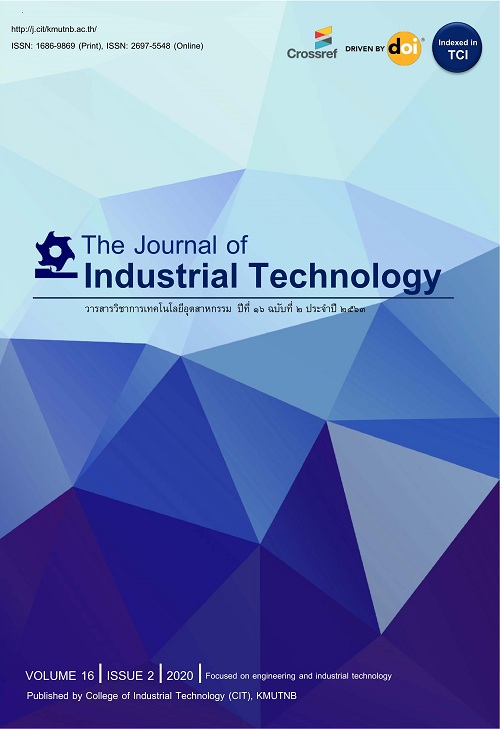Assessing Waste Generation Rate from Activities in High-Rise Building Construction for Achieving Sustainable Construction Goals
การประเมินอัตราการเกิดของเสียจากกิจกรรมในงานก่อสร้างอาคารสูงสำหรับการบรรลุเป้าหมายการก่อสร้างที่ยั่งยืน
Abstract
งานวิจัยนี้มีวัตถุประสงค์เพื่อวิเคราะห์อัตราการเกิดของเสียจากการก่อสร้างอาคารสูงประเภทที่ พักอาศัยสูง 8 ชั้น โดยศึกษาของเสียจากกิจกรรมงานโครงสร้างและงานสถาปัตยกรรม โดยภาพรวมพบว่าของเสียสามารถจำแนกได้เป็น 8 ประเภท ได้แก่ เศษคอนกรีต (50.5 %) เศษเหล็ก (25.5 %) เศษอิฐมวลเบา (12 %) เศษไม้แบบ (5.5 %) เศษกระเบื้อง (4.4 %) ขยะทั่วไป (1.6 %) บรรจุภัณฑ์หรือห่อวัสดุ (0.4 %) และ เศษพลาสติก PVC (0.1 %) ตามลำดับ โดยของเสียทั้งหมดมีปริมาณรวม 280 ตัน คิดเป็นอัตราการเกิดของเสียต่อพื้นที่ของอาคารที่ก่อสร้างประกอบด้วยเศษวัสดุของเสียหลักได้แก่ คอนกรีต (14.82 กก./ตร.ม.) เหล็ก (8.13 กก./ตร.ม.) อิฐ (3.82 กก./ตร.ม.) และไม้แบบ (1.76 กก./ตร.ม.) ตามลำดับ ส่วนงานสถาปัตยกรรมประกอบด้วยเศษกระเบื้อง (1.40 กก./ตร.ม.) ขยะมูลฝอยทั่วไป (0.51 กก./ตร.ม.) บรรจุภัณฑ์หรือห่อวัสดุ (0.13 กก./ตร.ม.) และ PVC (0.03 กก./ตร.ม.) ตามลำดับ กิจกรรมที่ก่อให้เกิดของเสียมากที่สุดในส่วนของงานโครงสร้าง ได้แก่ งานฐานราก รองลงมาได้แก่ คานยึดและผนัง รับแรงเฉือน พื้นอัดแรงภายหลัง เสา งานก่ออิฐมวลเบา และงานก่อผนังทั่วไป ตามลำดับ สำหรับงานสถาปัตยกรรม กิจกรรมที่ก่อให้เกิดของเสียมาก ได้แก่ งานฝ้าเพดาน งานตกแต่งพื้น และงานติดตั้งสุขภัณฑ์/อุปกรณ์ ตามลำดับ งานวิจัยนี้ชี้ให้เห็นถึงความสำคัญของการวางแผนจัดการของเสียโดยให้ความสำคัญกับกิจกรรมในงานก่อสร้างเพื่อลดของเสียจากสถานที่ก่อสร้าง เพื่อลดผลกระทบต่อสิ่งแวดล้อม และส่งเสริมการก่อสร้างที่ยั่งยืน
This research aims to analyze the waste generation rate from constructing high-rise residential buildings with more than 8 floors. The study focuses on waste from structural and architectural activities. Overall, waste was classified into eight types: concrete debris (50.5%), scrap metals (25.5%), lightweight brick debris (12.0%), formwork timber debris (5.5%), tile debris (4.4%), general waste (1.6%), packaging or material wrappings (0.4%), and PVC waste (0.1%), totaling 280 tons of waste. The waste generation rate per unit area of construction building consists of the main waste components as follows: concrete debris (16.12 kg/m2), scrap metals (8.13 kg/m2), brick debris (3.82 kg/m2), and formwork timber debris (1.76 kg/m2). For architectural work, the waste includes tile debris (1.40 kg/m2), general waste (0.51 kg/m2), packaging (0.13 kg/m2), and PVC waste (0.03 kg/m2). The structural activities with higher waste generation are foundation work followed by tie beam and shear wall work, post-tension slab work, columns, lightweight brick wall construction, and general wall construction. For architectural work, high waste-generating activities are ceiling work, floor finishing, and sanitary fittings installation, respectively. This study highlights the importance of waste management planning, emphasizing construction activities to reduce waste produced at site thus minimize environmental impact and promote sustainable construction.
Keywords
[1] V. Min, K. Panuwatwanich and K. Matsumoto, Enhancing performance of construction waste management: Factor analysis from the building contractors’ perspectives, Cleaner Waste Systems, 2024, 9, 100176.
[2] Z, Bao and W. Lu, Applicability of the environmental Kuznets curve to construction waste management: A panel analysis of 27 European economies, Resources, Conservation and Recycling, 2023, 188, 106667.
[3] S. Lee, H. Chang and J. Lee, Construction and demolition waste management and its impacts on the environment and human health: Moving forward sustainability enhancement, Sustainable Cities and Society, 2024, 115, 105855.
[4] H. Duan, T.R. Miller, G. Liu and V.W.Y. Tam, Construction debris becomes growing concern of growing cities, Waste Management, 2019, 83, 1–5.
[5] Y. Yi, J. Liu, M. C. Lavagnolo and A. Manzardo, Evaluating the carbon emission reduction in construction and demolition waste management in China, Energy and Buildings, 2024, 324, 114932.
[6] J. Soto-Paz, O. Arroyo, L.E. Torres-Guevara, B.A. Parra-Orobio and M. Casallas-Ojeda, The circular economy in the construction and demolition waste management: A comparative analysis in emerging and developed countries, Journal Building Engineering, 2023, 78, 107724.
[7] C. Yeeprae, T. Yomnak and T. Boonyaperm, Construction waste management for sustainable environment, Modern Management Journal, 2011, 9(1), 56–68. (in Thai)
[8] K. Kabirifar M. Mojtahedi, C.C. Wang and V.W.Y. Tam, Effective construction and demolition waste management assessment through waste management hierarchy; a case of Australian large construction companies, Journal of Cleaner Production, 2021, 312, 127790.
[9] S.Y. Kim, M.V. Nguyen and V.T.A. Luu, A performance evaluation framework for construction and demolition waste management: stakeholder perspectives, Engineering Construction and Architectural Management, 2020, 27(10), 3189-3213.
[10] N. Udawatta, J. Zuo, K. Chiveralls and G. Zillante, Improving waste management in construction projects: An Australian study. Resources, Conservation and Recycling, 2015, 101, 73-83.
[11] A.H. Assem and H. Karima, Material waste in the UAE construction industry: Main causes and minimization practices, Architectural Engineering and design management, 2011, 7(4), 221-235.
[12] U. Uyasatian and A. Ussawarujikulchai, Estimation of building-related C&D waste generation and composition in Bangkok, Environment and Natural Resources Journal, 2007, 5(2), 133-140. (in Thai).
[13] N. Pitchayapanya, Study of waste management from scraps construction materials in Miyake Seki Factory Project, SSRU Journal of Public Administration, 2018, 1(3), 35-48. (in Thai)
[14] S. Kittiwararat and P. Lertwattanaruk, Strategies for construction waste reduction in small residential buildings, Journal of Architectural/Planning Research and Studies, 2012, 9(2), 81-94. (in Thai)
[15] K. Doust, G. Battista and P. Rundle, Front-end construction waste minimization strategies, Australian Journal of Civil Engineering, 2020, 19(1), 1-11.
[16] W. Lu, Z. Bao, W.M.W. Lee, B. Chi and J. Wang, An analytical framework of “zero waste construction site”: Two case studies of Shenzhen, China, Waste Management, 2021, 121, 343-353.
[17] X. Zhao, R. Webber, P. Kalutara, W. Browne and J. Pienaar, Construction and demolition waste management in Australia: A mini-review, Waste Management and Research, 2022, 40(1), 34-46.
[18] S.H. Ghaffar, M. Burman and N. Braimah, Pathways to circular construction: An integrated management of construction and demolition waste for resource recovery, Journal of Cleaner Production, 2020, 244, 118710.
[19] Z.T. Abdullah, A sustainable recycling approach for construction: A case of remanufacturing waste rebar into steel nails, Results in Engineering, 2024, 23, 102777.
DOI: 10.14416/j.ind.tech.2025.04.001
Refbacks
- There are currently no refbacks.






